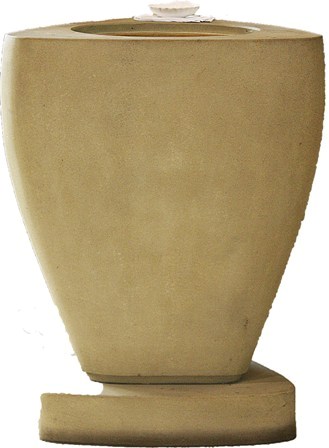The Font.

Carved out of a single block of stone the present font was another addition to the fabric of the church before its Consecration. Its shape was deliberately chosen – the three sides representing the Holy Trinity and reminding us of the Trinitarian formula used during the Sacrament of Baptism since the command of Jesus Christ to; "Go, therefore, make disciples of all nations, baptise them in the name of the Father, and of the Son and of the Holy Spirit..." (Matthew: 28: 19). The overall shape of the font resembles that of the womb symbolising the idea of Baptism as birth into new life in Christ. The metal lid, surmounted by the cross of St. Chad, is from the original font.
Overall, in the span of the history of the Church, the font is a relative newcomer. In the Apostolic Age, drawing from the Jewish heritage, the Sacrament of Baptism was administered without the use of a special font; natural sources of water being preferred. Tertullian makes reference to St. Peter baptising in the Tiber and the Venerable Bede makes reference to St. Paulinus administering the Sacrament of Baptism in the river Trent in the presence of King Edwin Ecclesiastical History ii, 16). The Didache, an early document from the first or second century, has the following description of the rite of Baptism: "The procedure for baptising is as follows. After repeating all that has been said, immerse in running water ‘In the Name of the Father, and of the Son, and of the Holy Ghost’. If no running water is available, immerse in ordinary water. This should be cold if possible, otherwise warm. If neither is practicable, then pour water three times on the head ‘In the Name of the Father, and of the Son, and of the Holy Ghost’."
The oldest western fonts are found in the catacombs of Rome in the form of cisterns hewn from the tufa in the floor of baptismal chapels. In its depictions in early Christian art, the font is nearly always shown as a shallow pool or basin in which the neophyte stands with feet immersed while water is poured over him from an overhead stream or from a vase held by the person baptising. The first baptisms were by full immersion. However, by the thirteenth century the practice of simply pouring water over the head of the person being baptised became gradually adopted possibly aided by the chill of northern European winters as the church spread out from its Mediterranean birthplace. As a result the amount of water needed decreased, the font became smaller and more shallow and was raised from the floor on a pier or column.
The positioning of the font at the entrance to the sanctuary accords with the directives of the Second Vatican Council calling on the faithful to be active participants in the celebration of the Sacraments. The original baptistery had been what is now the Lady Chapel and baptisms would have been semi-ptivate affairs with only the immediate family participating.